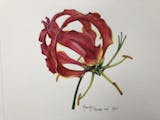Thank you very much, Pierre, for your wonderful 5-star review! We’re delighted to hear that our professional, fast, and local service continues to meet your expectations and that you’ve always been satisfied with your prints at Germotte. Your loyalty and trust truly mean a lot to us. We look forward to supporting you with your printing and framing projects for many years to come!
Thank you for leaving us a positive review! We are thrilled to hear that you are happy with your canvas print. It's always a pleasure to provide our customers with high-quality products. Thank you for choosing us!
Germotte.ca surpassed all of our expectations in their 14×12 mounted print on canvas of our beloved beagle. We are so impressed and so very grateful.
Thank you so much, Marsha! We're really happy to hear that you loved your 14×12 mounted canvas print of your beloved beagle. At Germotte, we put a lot of care into every print, and it means a lot to know we met your expectations. We truly appreciate your support and look forward to helping you with any future printing or framing needs!
It is always a pleasure dealing with the staff with Germotte. The service is very professional, friendly and courteous!
Hi Suzanne,
Thank you so much for your fantastic 5-star review! We’re thrilled to hear that you had a great experience working with our team at Germotte. Providing professional, friendly, and courteous service is always our top priority, and it’s wonderful to know it made a difference for you!
We’re also glad you chose our Metallic Photo Paper Print—it’s such a stunning option for showcasing vibrant colors and details. If there’s anything else we can help you with or if you’d like to explore more printing options, feel free to reach out anytime!
Thank you again for your kind words and support. We look forward to assisting you with your next project!
Warm regards,
Germotte Team
Hi Nathalie,
Thank you for your amazing 5-star review! It's fantastic to hear that you're pleased with the quality of our Enhanced matte photo prints and our customer service. We're thrilled that you consider us a great place for fine art prints.
We look forward to serving you again soon. If you need anything else, please feel free to reach out.
Best regards,
The Germotte Team
Every time I have something printed at Germotte, I'm always thrilled with the results. It's consistently high quality and done in a timely manner.
Hi Isobel
Thank you so much for your fantastic 5-star review! We're thrilled to hear that our canvas prints have consistently met your high expectations. It's wonderful to know you're always delighted with the quality and our prompt service.
We truly appreciate your continued trust in Germotte and look forward to printing more beautiful canvases for you in the future. Have a wonderful day.
Best regards,
The Germotte Team
I bought 2 prints, one was a moody almost all black print and it came out beautifully. It also arrived well packed. I plan to buy more. :)
Hi Sam, thank you so much for the amazing review! We're thrilled to hear you love the Enhanced Matte Photo Paper EMPP Prints, especially the moody black one. It's true, they really capture the darkness beautifully. We can't wait for you to add more to your collection! ✨
Thank you, Matt! We're so glad you love your new mural wallpaper. As your one-stop shop for all things beautiful walls, we pride ourselves on high-quality prints and fast delivery. Enjoy bringing your walls to life!
If you're ever thinking about tackling another home improvement project, Matt, remember that Germotte is more than just your wallpaper prints destination. We offer a wide range of services, from fine art prints, canvas prints, picture framing and wall coverings. Don't hesitate to reach out if you need a hand creating the perfect space for you.
Best Regards'
Germotte Theam
J'ai commandé un tirage 11x17 sur un papier baryté et le résultat est juste exceptionnel. Merci germotte pour le professionnalisme, le résultat est au delà de mes attentes.
Bonjour Marie-Aimée,
Merci beaucoup pour votre avis 5 étoiles ! Nous sommes ravis de savoir que vous êtes satisfaite de votre tirage.
Le papier baryté est un excellent choix pour les tirages d'art, car il offre une grande profondeur et une belle texture. Nous sommes heureux que vous ayez apprécié le résultat.
Notre objectif est de fournir des tirages d'art de haute qualité, et nous sommes toujours à la recherche de nouvelles façons d'améliorer notre service. Vos commentaires nous aident à atteindre cet objectif.
Merci encore pour votre soutien !
Cordialement,
Germotte Photo & Framing Studio
Another quality job. Germotte Photo and Framing is a must go to for Prints and Framing. Thank you for the quick turn around, exceptional quality and customer service.
Thank you, Rhonda Black, for your kind words and continued support! We appreciate your trust in Germotte Photo and Framing for your printing and framing needs.
I am extremely happy with the results of my Canvas Paper Prints. I started with 3- small (8x10) prints to see if this is the look I was seeking for the frames. Cannot say enough how thrilled I am with the quality of print, quickness of processing orders and the customer service. Will definitely be ordering soon for my seasonal projects., including some larger prints.
Thank you so much, Rhonda Black, for sharing your wonderful experience with our canvas paper prints! We're delighted to hear that you are extremely happy with the results, and that our small prints exceeded your expectations.
We're looking forward to assisting you with your seasonal projects and the larger prints you have in mind. If you ever need assistance or have any special requests, please don't hesitate to reach out. We're here to make your printing experience even better. Thanks for choosing Germottefor your canvas print needs!
As a regular customer , my latest canvas was great as usual at Germotte.
Thank you, Pierre, for your fantastic review and for being a regular customer at Germotte! We greatly appreciate your continued support and loyalty. It's wonderful to hear that you had another positive experience with our professional services and friendly staff. Your satisfaction is our top priority, and we're committed to consistently providing high-quality canvas prints. If you ever have any more printing projects or need assistance with anything else, please don't hesitate to reach out. We look forward to serving you again in the future!
I needed to get a high quality print made and then mailed to a museum in Nova Scotia. The fine folks at Germotte handled the whole thing seamlessly and in a timely manner. They even suggested a tweak that improved the quality of the print. Feedback from the Curator is that the print looks wonderful and will be framed and placed in a display. Can’t ask for more than that! Germotte is my go-to for anything to do with art, framing and shipping. Great work!
Dear William Pullen,
Thank you so much for taking the time to share your wonderful experience with our William Turner Fine Art Paper Prints. We are absolutely thrilled to hear that your high-quality print made its way to the museum in Nova Scotia seamlessly and in a timely manner.
It's fantastic to know that our team at Germotte could assist you effectively and even offer a suggestion that improved the quality of the print. We are dedicated to providing the best service possible and it's heartening to receive feedback that the Curator is pleased with how the print looks and that it will be displayed prominently.
Your kind words and trust in us as your go-to for all things related to art, framing, Fine art printing and shipping mean a lot to us. We're honored to have played a role in bringing your vision to life and ensuring that your artwork is showcased beautifully.
Thank you again for your glowing review and for choosing Germotte Photo & framing Studio. We look forward to serving you with the same level of excellence in the future.
Best regards,
Germotte team
I was extremely pleased with my acrylic photo that I had sent to Germotte framing and photo studio. It brought the photo to life for me. I would highly recommend them and will use them again in the future.
Thank you so much for taking the time to leave us a wonderful 5-star review, Sharon! We're thrilled to hear that our Acrylic Prints service at Germotte Photo & Framing Studio brought your photo to life in such a remarkable way.
We greatly appreciate your recommendation and are honored to be your choice for this special project. We look forward to serving you again in the future and helping you transform more of your memories into stunning artworks.
I had to get two family photos enlarged and shipped to Nova Scotia. Germotte handled the entire transaction seamlessly and I met the deadline to get the pictures to the addressee. This is the third or fourth time Germotte has done this sort of work for me and every time they’ve exceeded expectations. They are my go-to photo and framing work.
Thank you, William, for taking the time to leave us a wonderful 5-star review for your recent order of Epson Premium Luster Photo Prints! We're delighted to hear that you are pleased with the quality of our work and the level of service you received.
It's fantastic to know that we were able to handle the enlargement and shipping of your family photos to Nova Scotia seamlessly. Meeting your deadline and ensuring the safe delivery of the pictures to the intended recipient is always our top priority.
We appreciate your continued trust and loyalty in choosing Germotte for your photo and framing needs. Your satisfaction is our ultimate goal, and we're thrilled that we've consistently exceeded your expectations throughout the various projects we've worked on together.
If there's anything else we can assist you with or if you have any further photo or framing requests in the future, please don't hesitate to reach out. We're here to provide you with fabulous work and great service each time you choose Germotte.
Our little dog passed away on March 1st. We had a photo of her and Germotte p[printed the photo on canvas. The work was museum quality and the service including the follow up to ensure we had received it was truly amazing. I would not hesitate to recommend Germotte to anyone!! Thank yo.
Dear Paul Beaudoin,
Thank you so much for taking the time to leave such a wonderful 5-star review for our Canvas Prints & Stretch 3/4' Bars. We are truly sorry to hear about the loss of your beloved dog. It warms our hearts to know that we could be a part of preserving the memory of your furry friend.
Your recommendation means the world to us! We are grateful for your trust and confidence in our services. If you ever need assistance in the future or have any further inquiries, please don't hesitate to reach out. We're here to help.
Once again, thank you for choosing Germotte. We wish you all the best and hope that the canvas print brings you fond memories of your beloved dog for years to come.
Warm regards,
Germotte Customer Support
I will be using Germotte for all of my art prints! Not only was it quick to get my print but the quality is amazing. The staff are also wonderful! All round fabulous experience and product.
Dear Susan,
Thank you so much for your glowing 5-star review! We're thrilled to hear that you had a fabulous experience with Germotte and that you're satisfied with the quality of your art print. Our team takes great pride in providing excellent service, and it's wonderful to know that we met your expectations. We look forward to serving you again in the future for all your art print needs!
Best regards
Germotte Studio
This was my first time printing an enlargement of my watercolour artwork and I have to say I was pleasantly surprised at the quality of the output from Germotte. The owner was also very helpful at offering tips to take better photos of the original to make for better reproductions.
Thank You for Your Wonderful Review, H Tsang!
Dear H Tsang,
Thank you so much for taking the time to share your experience with us! We're thrilled to hear that you're happy with the quality of your enlarged watercolour print on our Textured Fine Art paper.
As a team, we always strive to provide the best possible service to our customers, and it warms our hearts to know that our efforts paid off in your case. We're glad that our owner could offer you valuable advice on capturing your original artwork for even better reproductions.
Your satisfaction means the world to us, and we hope to continue exceeding your expectations in the future. If you ever have any more projects or questions, please don't hesitate to reach out to us. We'd be more than happy to help.
Once again, thank you for your kind words, and we look forward to working with you again soon!
Warm regards,
Germotte Team
This is my second time using Germotte Photo and a Framing Studio to print and dry mount my digital drawings.
Excellent, caring customer service
Timely turnaround
Competitive pricing
Shipping and hand delivery to my home was an unexpected perk
Professional service all around
I highly recommend
Thank you so much Donna for leaving such a kind and positive review of your experience with Germotte Photo and Framing Studio. We are thrilled to hear that you were satisfied with the Medite dry mounting service we provided for your digital drawings.
It's wonderful to hear that you appreciated our excellent customer service and timely turnaround and competitive pricing.
Thank you for your recommendation and for trusting Germotte with your digital drawing needs.
Very knowledgeable, friendly service….and the quality of their prints were spectacular!
Thank you for your kind words, Steve! We're glad to hear that you had a great experience with our service and that you were impressed by the quality of our Photo Rag Fine Art Paper prints. We strive to provide the best possible service and products to all of our customers, and it's always rewarding to receive positive feedback like yours. We hope to see you again soon!
The prints I recently had done were beautifully done. Always happy with anything I have done at Germotte!
Thank you K Bell! We sincerely appreciate your feedback and are thrilled to hear that you were pleased with our services. Your satisfaction is very important to us and we look forward to helping you with future prints!
I have been going to Germotte for a couple of years now and mostly for their Ready Made Frames. The frames are hand made on site, professionally done, high quality and a great selection of sizes. The services is professional, fast and courteous. Never been disappointed. My go to place for all my framing requirement.
Thank you Josee for your wonderful review! We're so glad to hear that you have been consistently satisfied with the quality of our products and service. We take pride in providing our customers with only the best, and it's a pleasure to know that we have succeeded in doing this for you. Thank you again for your kind words!
I recently had 4 photos printed by Germotte on this paper. They turned out beautifully; crisp with rich colours. Always happy with Germotte's work!
Thank you Isobel for your review! We're happy to have helped you out and that you're pleased with the results.
Added a border and explained the process for someone who had never printed before.
usually do the canvas prints but this time I choose to do a print . It came out so clear and the colors just popped . It truly is now worth framing !! . Once again Germotte has done an exceptional job !!
Thank you so much for your kind words, Gord! We're thrilled to hear that you're happy with your print and that the colors popped - that's always our goal! We hope you enjoy it for many years to come.























